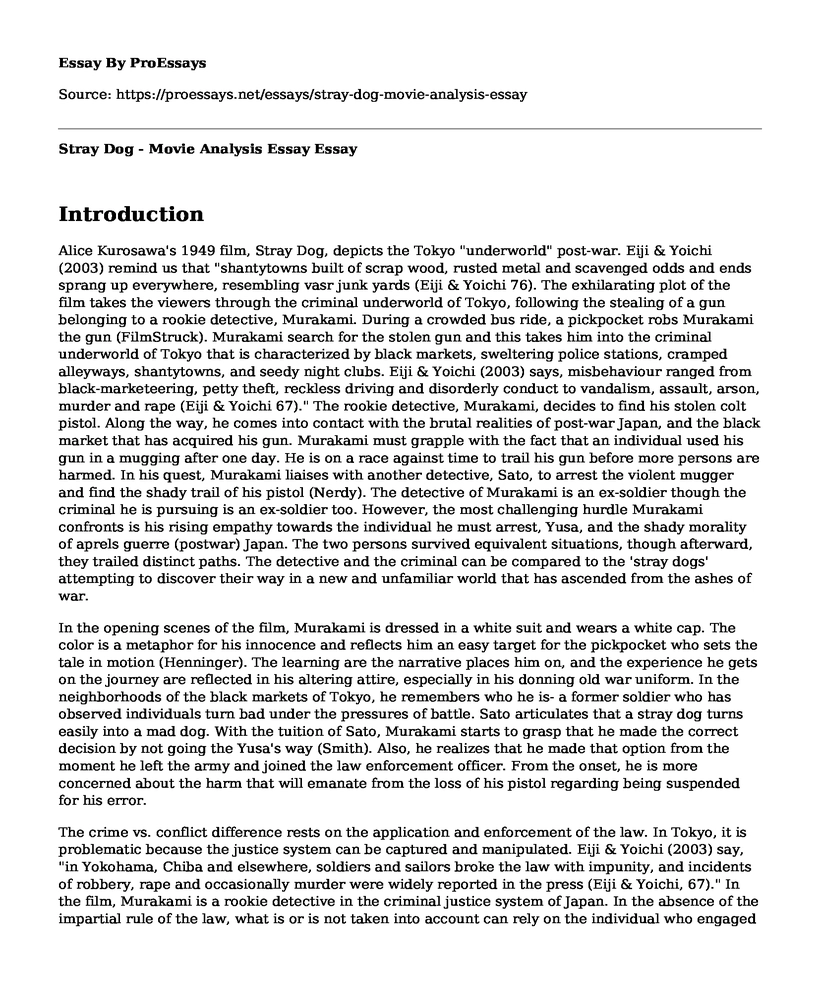Introduction
Alice Kurosawa's 1949 film, Stray Dog, depicts the Tokyo "underworld" post-war. Eiji & Yoichi (2003) remind us that "shantytowns built of scrap wood, rusted metal and scavenged odds and ends sprang up everywhere, resembling vasr junk yards (Eiji & Yoichi 76). The exhilarating plot of the film takes the viewers through the criminal underworld of Tokyo, following the stealing of a gun belonging to a rookie detective, Murakami. During a crowded bus ride, a pickpocket robs Murakami the gun (FilmStruck). Murakami search for the stolen gun and this takes him into the criminal underworld of Tokyo that is characterized by black markets, sweltering police stations, cramped alleyways, shantytowns, and seedy night clubs. Eiji & Yoichi (2003) says, misbehaviour ranged from black-marketeering, petty theft, reckless driving and disorderly conduct to vandalism, assault, arson, murder and rape (Eiji & Yoichi 67)." The rookie detective, Murakami, decides to find his stolen colt pistol. Along the way, he comes into contact with the brutal realities of post-war Japan, and the black market that has acquired his gun. Murakami must grapple with the fact that an individual used his gun in a mugging after one day. He is on a race against time to trail his gun before more persons are harmed. In his quest, Murakami liaises with another detective, Sato, to arrest the violent mugger and find the shady trail of his pistol (Nerdy). The detective of Murakami is an ex-soldier though the criminal he is pursuing is an ex-soldier too. However, the most challenging hurdle Murakami confronts is his rising empathy towards the individual he must arrest, Yusa, and the shady morality of aprels guerre (postwar) Japan. The two persons survived equivalent situations, though afterward, they trailed distinct paths. The detective and the criminal can be compared to the 'stray dogs' attempting to discover their way in a new and unfamiliar world that has ascended from the ashes of war.
In the opening scenes of the film, Murakami is dressed in a white suit and wears a white cap. The color is a metaphor for his innocence and reflects him an easy target for the pickpocket who sets the tale in motion (Henninger). The learning are the narrative places him on, and the experience he gets on the journey are reflected in his altering attire, especially in his donning old war uniform. In the neighborhoods of the black markets of Tokyo, he remembers who he is- a former soldier who has observed individuals turn bad under the pressures of battle. Sato articulates that a stray dog turns easily into a mad dog. With the tuition of Sato, Murakami starts to grasp that he made the correct decision by not going the Yusa's way (Smith). Also, he realizes that he made that option from the moment he left the army and joined the law enforcement officer. From the onset, he is more concerned about the harm that will emanate from the loss of his pistol regarding being suspended for his error.
The crime vs. conflict difference rests on the application and enforcement of the law. In Tokyo, it is problematic because the justice system can be captured and manipulated. Eiji & Yoichi (2003) say, "in Yokohama, Chiba and elsewhere, soldiers and sailors broke the law with impunity, and incidents of robbery, rape and occasionally murder were widely reported in the press (Eiji & Yoichi, 67)." In the film, Murakami is a rookie detective in the criminal justice system of Japan. In the absence of the impartial rule of the law, what is or is not taken into account can rely on the individual who engaged in the crime and who is doing the enforcing instead of the legality of the deed itself. Eiji & Yoichi (2003) say, "the government hoped to protect the daughters of the wellborn and middle classes by having lower-class women satisfy the sexual appetites of battle-weary Gis" (Eiji & Yoichi, 68). When the law becomes another tool of the people in power, the boundaries alienating the legal and extralegal grow blurred. Eiji & Yoichi (2003) say, "military courts arrested relatively few soldiers for these offences and convicted even fewer, and restitution for the victims was rare" (Eiji & Yoichi, 68).
Works Cited
FilmStruck. "Stray Dog, Akira Kurosawa, 1949 - Showdown Scene." YouTube, 7 Nov. 2017, www.youtube.com/watch?v=-yielLYZ5lo. Accessed 28 Jan. 2020.
Henninger, Jason. "Akira Kurosawa's Stray Dog." Tor.com, 24 Mar. 2015, www.tor.com/2011/08/15/akira-kurosawas-stray-dog/. Accessed 28 Jan. 2020.
Nerdy, Inc. "YouTube." YouTube, 9 Jan. 2016, www.youtube.com/watch?v=CIKaqxgZgx8. Accessed 28 Jan. 2020.
Smith, Mark C. "FILM : Akira Kurosawa's 'Stray Dog' Knows Where It's Going." Los Angeles Times, 6 June 1991, www.latimes.com/archives/la-xpm-1991-06-06-ol-135-story.html.
Eiji, Takemae, and Yoichi Nakano. "Inside GHQ: The allied occupation of Japan and its legacy." Pacific Affairs 76.3 (2003): 475.
Cite this page
Stray Dog - Movie Analysis Essay. (2023, Mar 28). Retrieved from https://proessays.net/essays/stray-dog-movie-analysis-essay
If you are the original author of this essay and no longer wish to have it published on the ProEssays website, please click below to request its removal:
- Greek and Egyptian Fashion Essay
- Theme and Symbols Combine With Stories: Paper Example
- Syntax, Sentence Structure, and Punctuation - Essay Sample
- Essay Sample on People Magazine: America's Most Popular Magazine
- Cinema: Combining Technology, Aesthetics, Entertainment & Business - Essay Sample
- The Lincoln Film - Movie Analysis Essay
- Essay on Ennio Morricone's Final Performance: 90-Year-Old Musician Retires in London







